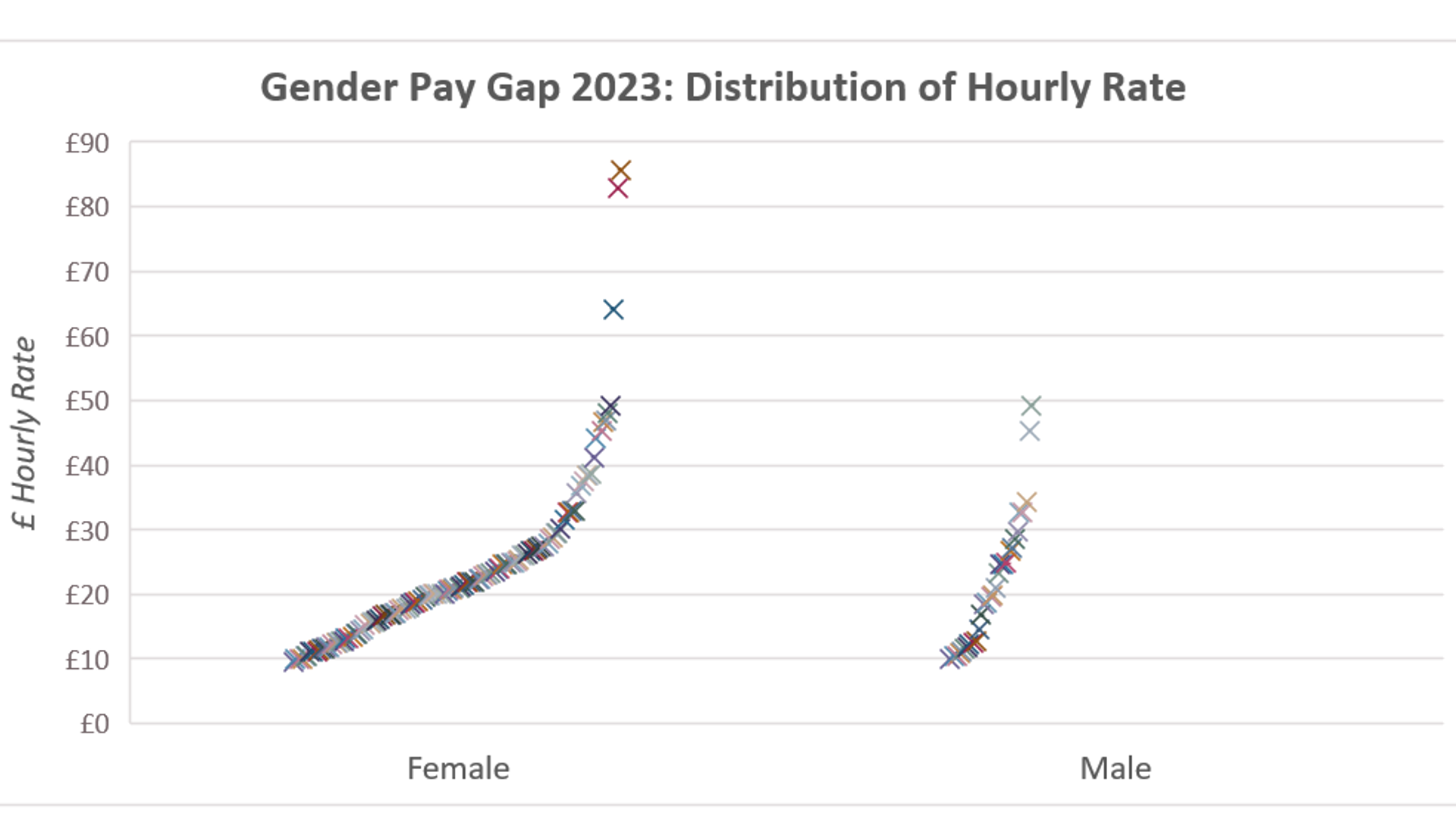BPAS is required by law to report the figures detailed below on the Government Equalities Office website, by 04 April 2024, calculated using snapshot data from 05 April 2023.
This legal requirement has been in place since 2017 and it is expected that when publishing 2023 figures, organisations should be transparent with their previous years’ comparison data.
The latest data, with previous years as a comparison, is detailed below. It should be noted the requirement to report Gender Pay Gap data was suspended during 2020.
| 2023 | 2022 | 2021 | 2019 | 2018 | 2017 | |
| Mean gender pay gap | 15.3% | 27.8% | 23.9% | 18.3% | 21.9% | 24.8% |
| Median gender pay gap | 3.5% | 7.0% | 7.7% | 12.2% | 13.8% | 15.6% |
| Proportion of males receiving bonus payment | 0.0% | 0.0% | 0.0% | 0.0% | 0.0% | 0.0% |
| Proportion of females receiving bonus payment | 0.1% | 0.0% | 0.0% | 0.0% | 0.0% | 0.0% |
| 2023 | 2022 | 2021 | 2019 | 2018 | 2017 | |
| Proportion of male and females in each quartile band | F M | F M | F M | F M | F M | F M |
|
Lower Quartile < 12.77 |
94% 6% | 89% 8% | 93% 7% | 90% 10% | 92% 8% | 92% 8% |
|
Lower Middle Quartile <=12.77 > 18 |
96% 4% | 91% 4% | 96% 4% | 96% 4% | 96% 5% | 97% 4% |
|
Upper Middle Quartile <=18 > 20.5 |
98% 2% | 89% 4% | 95% 5% | 97% 3% | 96% 4% | 96% 4% |
|
Upper Quartile >=20.5 |
90% 10% | 85% 12% | 87% 13% | 89% 11% | 89% 12% | 88% 12% |

Statutory Requirements
The name and job title of the senior person who signed these calculations off, and who is responsible for the data, will be published alongside the statistics. BPAS is also required to add this information to our website, which provides the opportunity to give more detail and context to our results.
This statement and the published information relating to our Gender Pay Gap is accurate.
Lucy Moore
Executive Chair
Sam Smethers
BPAS Trustee & Governance, Remuneration & Nomination Committee Chair
06 March 2024
Appendix 1 – Detail of Calculations
Workers - Inclusions and Exclusions
| Group of Workers | Included/Excluded from Calculations | Commentary |
| Contracted employees | Included | |
| Casual Workers | Excluded |
The ACAS guidance refers to ‘employees that do not receive basic pay’ being included, however Casuals are not considered to be employees. |
| Self Employed Doctors working under Practising Privileges | Excluded | We are invoiced for the work these individuals undertake and this is by session rather than against a specific number of hours. They are not paid through the payroll. We have limited control over the rates we are charged under these agreements. |
| Agency workers | Excluded | ACAS guidance confirms that agency workers are part of the calculation to understand if we are a big enough business to warrant publishing the pay gap; but are not included in the actual pay calculations. |
| Those on Maternity leave (SMP) or sick leave receiving no pay | Excluded | In line with ACAS guidance |
| Those who had left prior to 5th April 2023 | Excluded |
Pay – Inclusions and Exclusions
| Pay Element | Included/Excluded from Calculations | Commentary |
| Basic salary | Included | In line with ACAS guidance |
| London Weighting | Included | In line with ACAS guidance |
| Overtime | Excluded | In line with ACAS guidance |
| Allowances | Included | In line with ACAS guidance |
| Car allowance | Included | In line with ACAS guidance |
| LARC payment | Included | In line with ACAS guidance |
| Premium Pay | Included | In line with ACAS guidance |
| Bonus | Included | In line with guidance |
| Trainer honorarium | Excluded | Considered immaterial as does not apply to any staff members |
Other data principles applied
Where individuals have two different hourly rates (for two different jobs) these have been averaged. There are very few individuals with significantly differing rates
BPAS is not only committed to protecting and extending women’s reproductive rights and choices; but also to supporting women’s rights in a much broader sense. As such, we take the Gender Pay Gap seriously, and whilst we are pleased to note that our pay gap has closed significantly in the past year, we are committed to understanding (beyond the headline statistics) why we continue to have a pay gap and what we might be able to do to further reduce it.
Firstly, it is important to note that gender pay reporting is different to equal pay. The (legal) right to equal pay relates to men and women receiving equal pay for work of equal value – a principle which we absolutely hold true and ensure is embedded into our gender-neutral pay structures.
Gender pay figures, however, show the difference in average pay between all men and women within the whole workforce. This may mean that where there are proportionately more men in senior roles than in less senior roles, the gap between what men are paid on average and what women are paid on average, is greater.
At BPAS, we believe that there are a number of factors contributing to our pay gap, and we have therefore taken the opportunity to look into some of the detail and context around our figures, provided in our report below.
Further detail on average hourly rates and pay gaps by section of the workforce
| 2023 Average Hourly Rates | 2022 Average Hourly Rates | |||||
| Type of role | Female | Male | Difference | Female | Male | Difference |
| Appointment Advisor | £12.07 | £12.80 | 6% | £11.89 | £11.22 | -6% |
| Nurse/ Midwife Practitioner | £19.36 | £19.19 | -1% | £17.76 | £18.13 | 2% |
| Healthcare Assistant | £11.54 | £10.57 | -8% | N/A | £10.93 | N/A |
| Doctor/ Surgeon | £45.31 | £45.30 | 0% | £46.70 | £42.70 | -9% |
| Non-clinical Roles | £12.72 | £15.37 | 21% | £12.91 | £15.40 | 19% |
| Clinical Management | £23.90 | N/A | N/A | £18.29 | £19.67 | 8% |
| Non-clinical Management | £22.03 | £24.63 | 12% | £21.99 | £21.01 | -4% |
| Senior Management Team (inc ELT) | £56.62 | £49.28 | -13% | £40.49 | £45.95 | 13% |
BPAS considers that the above percentages are more accurate reflections of the pay gaps we have which are within our control to address. There are 3 sections of our workforce which now show a negative pay gap, as evidenced above.
The primary factor driving the closing of the mean gender pay gap is the composition of our senior management team, which is now only 8% male (was previously 23% male) - with 2 male staff previously earning over £100k annually both exiting BPAS within the reporting period, resulting in a negative gender pay gap. In addition, a further 4 Non-Clinical Management male staff previously within the upper quartile and earning over £50k annually also exited the organisation within the period.
Our Executive Leadership Team in 2023 is 89% female (was 77% female in 2022). Our Board of Trustees, whilst not remunerated, is 71% female (was 75% female in 2022).
At the time of calculating the statistics, our workforce was 94% female, having become more gender unbalanced since 05 April 2022 (was previously 89% female).
We have a large number of part time positions within our organisation, the vast majority of which are nurses / midwives. At the time of reporting our workforce was made up as follows:
| Part time |
Full time |
|
| Female | 65.5% | 28.7% |
| Male | 1.7% | 4.1% |
Our Pay Structure
For all roles, BPAS operates a formal job evaluation process, and applies a graded pay structure for the vast majority of those roles (where job roles are attached to specific pay bands). Our clinical roles are benchmarked against the NHS Agenda for Change pay rates, Doctor roles against NHS rates and independent health sector rates, and our non-clinical roles benchmarked against UK median pay rates.
For non-clinical roles, BPAS benchmarks against UK median pay rates, and naturally finds that we need to reflect these higher market rates in order to be able to attract and retain the right people for our charity.
Pay in the Health Sector
Pay for nurses and midwives is largely determined by the NHS and has been historically relatively low and often suppressed by limits on public spending.
Summary and conclusion
Pulling all of the themes above together, BPAS believes that our Gender Pay Gap is as a result of all of the following contributing factors:
- Vastly more women than men in nursing / midwifery roles UK-wide
- BPAS’ ability to offer mainly part time roles, particularly in the female-dominated professions, and full-time roles in higher paid positions
BPAS is confident that our gender pay gap is not unusual in the sector(s) in which we operate, and we are pleased to see that over the past year both our mean and median gender pay gaps have closed significantly.
The future - Narrowing the gap
BPAS commits to:
- Continuing detailed analysis into different sections of our workforce, thus determining priority areas to focus on
- Continuing to ensure that equality is at the centre of our recruitment and attraction strategies, with a focus on ensuring that women are actively encouraged to apply for traditionally male-dominated roles (and vice versa for men)
- Regularly reviewing our Gender Pay Gap and benchmarking against similar organisations within the sector(s) we operate in
- Identifying further plans of action as more knowledge and understanding is gained
- A full Pay Strategy review during 2024
- Developing our reporting practices to consider and include our Ethnicity Pay Gap, in support of our commitment to Equality, Diversity & Inclusion and being as transparent as possible.
Lucy Moore
Executive Chair
Sam Smethers
BPAS Trustee & Governance, Remuneration & Nomination Committee Chair
